Evidence-Based Nursing Research Report: Passive Exercise in Aged Care
VerifiedAdded on 2020/04/13
|18
|3649
|106
Report
AI Summary
This research report investigates the provision of passive exercise in Australian aged care facilities, focusing on its frequency, benefits, and impact on elderly residents. The study explores whether carers provide passive exercise daily, examining the types of exercises, frequency of participation, and the impact on functional fitness. The methodology involves a mixed-method approach, including interviews with carers and the use of questionnaires. Data analysis includes both qualitative and quantitative methods, with statistical analysis to assess the effect of passive exercise on functional parameters. The research aims to identify barriers and facilitators to passive exercise, contributing to the development of standard protocols and improved care practices. Ethical considerations, including informed consent and data privacy, are addressed throughout the study. The findings are expected to inform evidence-based nursing practice and enhance the quality of care for older adults in aged care settings, particularly those with limited mobility. The research also highlights the importance of collaboration with physiotherapists to determine the most effective exercise regimens.
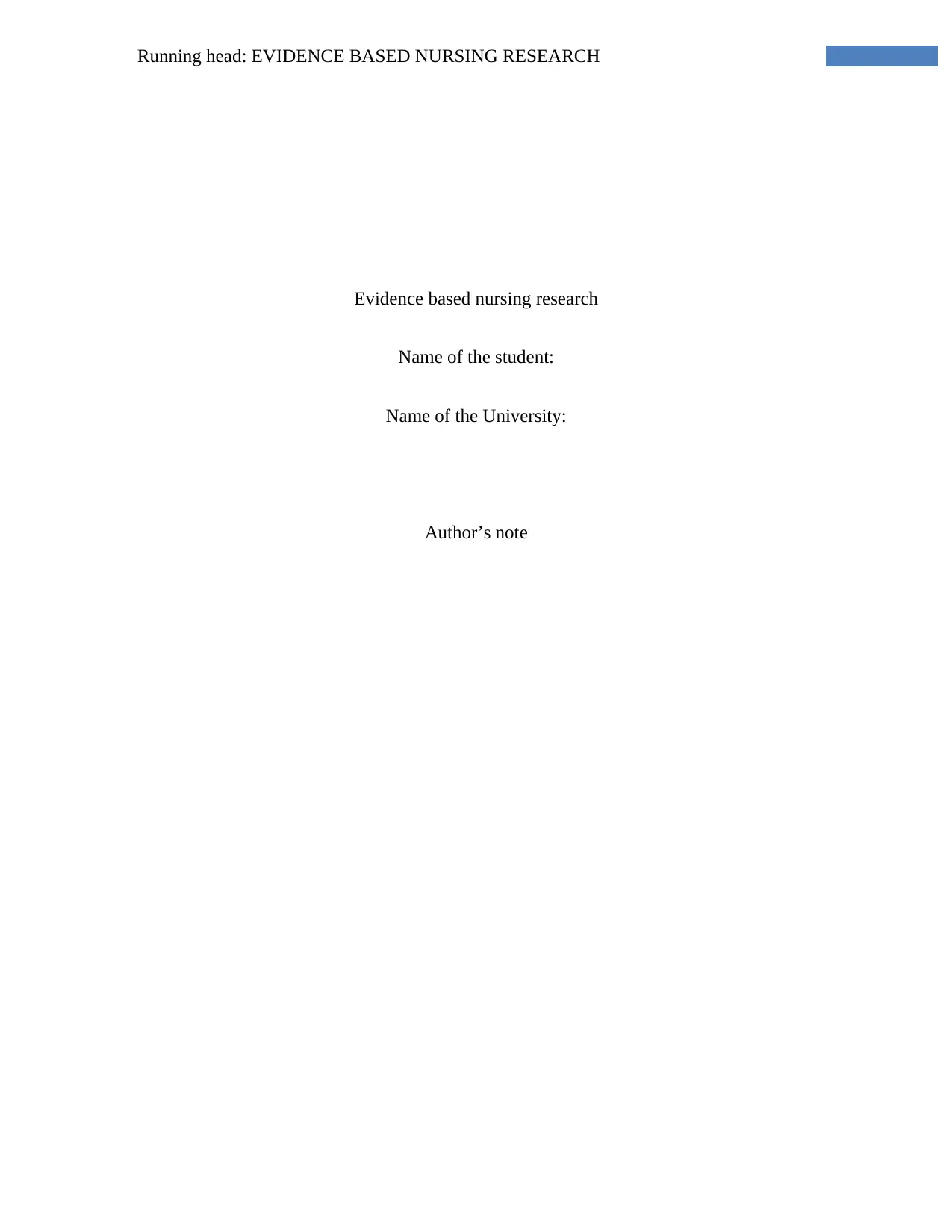
Running head: EVIDENCE BASED NURSING RESEARCH
Evidence based nursing research
Name of the student:
Name of the University:
Author’s note
Evidence based nursing research
Name of the student:
Name of the University:
Author’s note
Paraphrase This Document
Need a fresh take? Get an instant paraphrase of this document with our AI Paraphraser
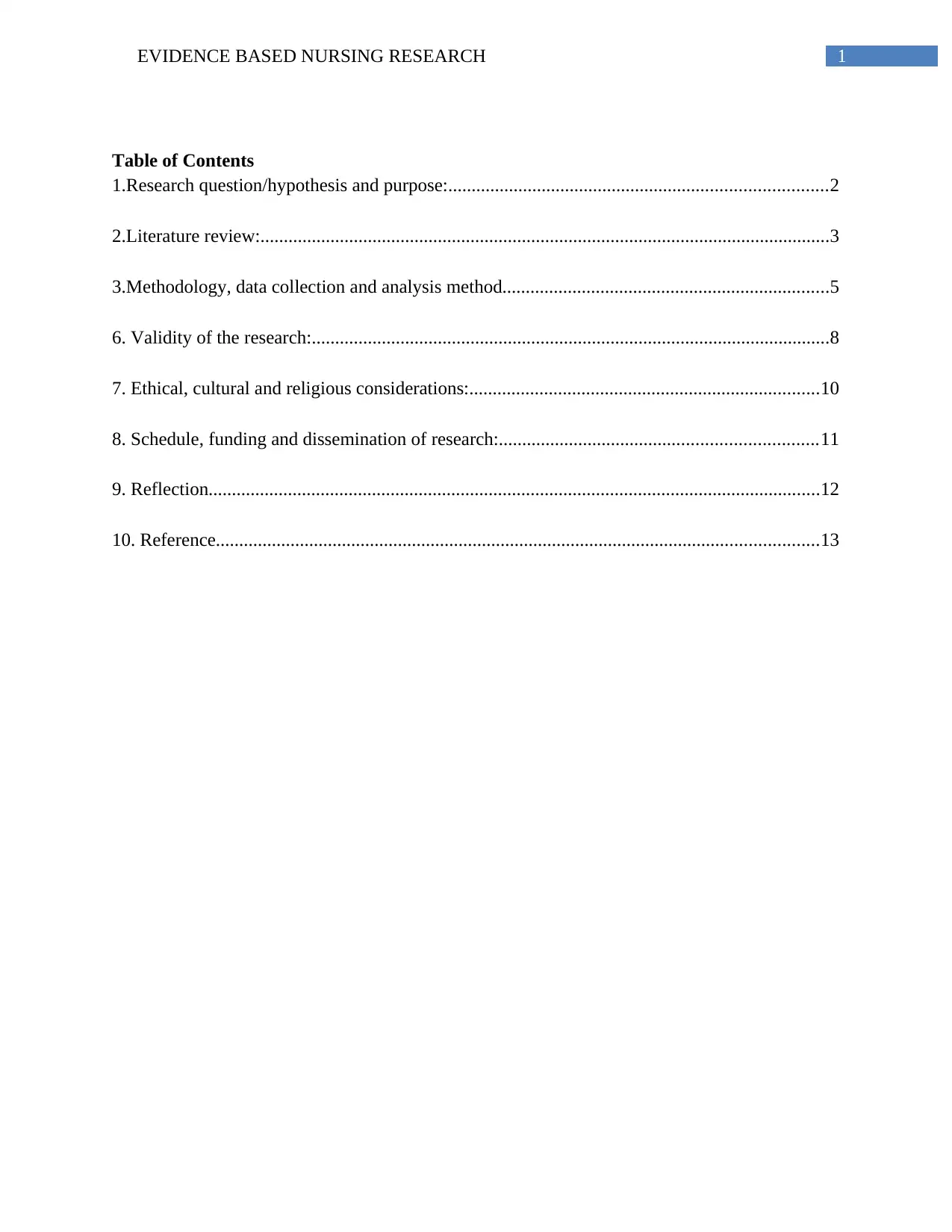
1EVIDENCE BASED NURSING RESEARCH
Table of Contents
1.Research question/hypothesis and purpose:.................................................................................2
2.Literature review:..........................................................................................................................3
3.Methodology, data collection and analysis method......................................................................5
6. Validity of the research:...............................................................................................................8
7. Ethical, cultural and religious considerations:...........................................................................10
8. Schedule, funding and dissemination of research:....................................................................11
9. Reflection...................................................................................................................................12
10. Reference.................................................................................................................................13
Table of Contents
1.Research question/hypothesis and purpose:.................................................................................2
2.Literature review:..........................................................................................................................3
3.Methodology, data collection and analysis method......................................................................5
6. Validity of the research:...............................................................................................................8
7. Ethical, cultural and religious considerations:...........................................................................10
8. Schedule, funding and dissemination of research:....................................................................11
9. Reflection...................................................................................................................................12
10. Reference.................................................................................................................................13
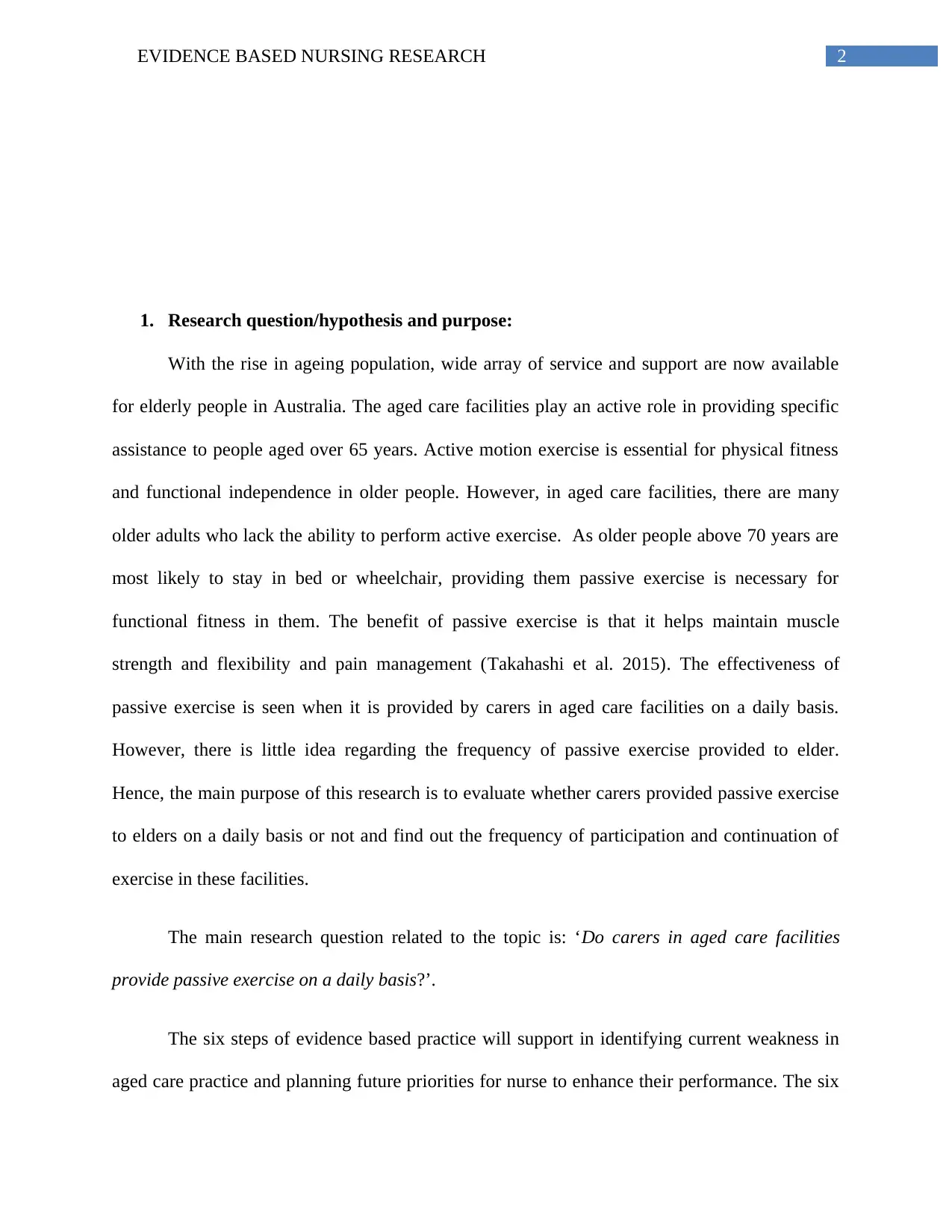
2EVIDENCE BASED NURSING RESEARCH
1. Research question/hypothesis and purpose:
With the rise in ageing population, wide array of service and support are now available
for elderly people in Australia. The aged care facilities play an active role in providing specific
assistance to people aged over 65 years. Active motion exercise is essential for physical fitness
and functional independence in older people. However, in aged care facilities, there are many
older adults who lack the ability to perform active exercise. As older people above 70 years are
most likely to stay in bed or wheelchair, providing them passive exercise is necessary for
functional fitness in them. The benefit of passive exercise is that it helps maintain muscle
strength and flexibility and pain management (Takahashi et al. 2015). The effectiveness of
passive exercise is seen when it is provided by carers in aged care facilities on a daily basis.
However, there is little idea regarding the frequency of passive exercise provided to elder.
Hence, the main purpose of this research is to evaluate whether carers provided passive exercise
to elders on a daily basis or not and find out the frequency of participation and continuation of
exercise in these facilities.
The main research question related to the topic is: ‘Do carers in aged care facilities
provide passive exercise on a daily basis?’.
The six steps of evidence based practice will support in identifying current weakness in
aged care practice and planning future priorities for nurse to enhance their performance. The six
1. Research question/hypothesis and purpose:
With the rise in ageing population, wide array of service and support are now available
for elderly people in Australia. The aged care facilities play an active role in providing specific
assistance to people aged over 65 years. Active motion exercise is essential for physical fitness
and functional independence in older people. However, in aged care facilities, there are many
older adults who lack the ability to perform active exercise. As older people above 70 years are
most likely to stay in bed or wheelchair, providing them passive exercise is necessary for
functional fitness in them. The benefit of passive exercise is that it helps maintain muscle
strength and flexibility and pain management (Takahashi et al. 2015). The effectiveness of
passive exercise is seen when it is provided by carers in aged care facilities on a daily basis.
However, there is little idea regarding the frequency of passive exercise provided to elder.
Hence, the main purpose of this research is to evaluate whether carers provided passive exercise
to elders on a daily basis or not and find out the frequency of participation and continuation of
exercise in these facilities.
The main research question related to the topic is: ‘Do carers in aged care facilities
provide passive exercise on a daily basis?’.
The six steps of evidence based practice will support in identifying current weakness in
aged care practice and planning future priorities for nurse to enhance their performance. The six
⊘ This is a preview!⊘
Do you want full access?
Subscribe today to unlock all pages.

Trusted by 1+ million students worldwide
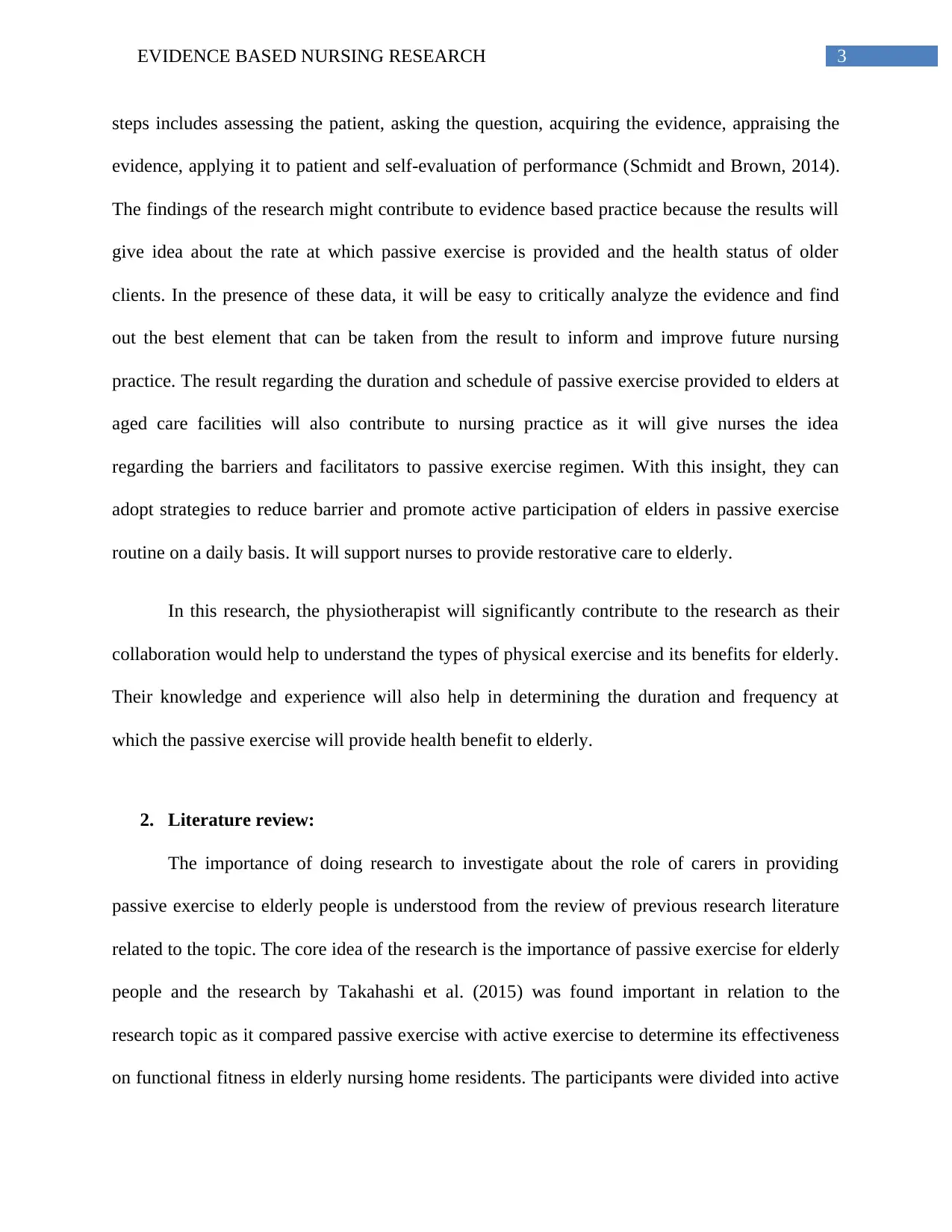
3EVIDENCE BASED NURSING RESEARCH
steps includes assessing the patient, asking the question, acquiring the evidence, appraising the
evidence, applying it to patient and self-evaluation of performance (Schmidt and Brown, 2014).
The findings of the research might contribute to evidence based practice because the results will
give idea about the rate at which passive exercise is provided and the health status of older
clients. In the presence of these data, it will be easy to critically analyze the evidence and find
out the best element that can be taken from the result to inform and improve future nursing
practice. The result regarding the duration and schedule of passive exercise provided to elders at
aged care facilities will also contribute to nursing practice as it will give nurses the idea
regarding the barriers and facilitators to passive exercise regimen. With this insight, they can
adopt strategies to reduce barrier and promote active participation of elders in passive exercise
routine on a daily basis. It will support nurses to provide restorative care to elderly.
In this research, the physiotherapist will significantly contribute to the research as their
collaboration would help to understand the types of physical exercise and its benefits for elderly.
Their knowledge and experience will also help in determining the duration and frequency at
which the passive exercise will provide health benefit to elderly.
2. Literature review:
The importance of doing research to investigate about the role of carers in providing
passive exercise to elderly people is understood from the review of previous research literature
related to the topic. The core idea of the research is the importance of passive exercise for elderly
people and the research by Takahashi et al. (2015) was found important in relation to the
research topic as it compared passive exercise with active exercise to determine its effectiveness
on functional fitness in elderly nursing home residents. The participants were divided into active
steps includes assessing the patient, asking the question, acquiring the evidence, appraising the
evidence, applying it to patient and self-evaluation of performance (Schmidt and Brown, 2014).
The findings of the research might contribute to evidence based practice because the results will
give idea about the rate at which passive exercise is provided and the health status of older
clients. In the presence of these data, it will be easy to critically analyze the evidence and find
out the best element that can be taken from the result to inform and improve future nursing
practice. The result regarding the duration and schedule of passive exercise provided to elders at
aged care facilities will also contribute to nursing practice as it will give nurses the idea
regarding the barriers and facilitators to passive exercise regimen. With this insight, they can
adopt strategies to reduce barrier and promote active participation of elders in passive exercise
routine on a daily basis. It will support nurses to provide restorative care to elderly.
In this research, the physiotherapist will significantly contribute to the research as their
collaboration would help to understand the types of physical exercise and its benefits for elderly.
Their knowledge and experience will also help in determining the duration and frequency at
which the passive exercise will provide health benefit to elderly.
2. Literature review:
The importance of doing research to investigate about the role of carers in providing
passive exercise to elderly people is understood from the review of previous research literature
related to the topic. The core idea of the research is the importance of passive exercise for elderly
people and the research by Takahashi et al. (2015) was found important in relation to the
research topic as it compared passive exercise with active exercise to determine its effectiveness
on functional fitness in elderly nursing home residents. The participants were divided into active
Paraphrase This Document
Need a fresh take? Get an instant paraphrase of this document with our AI Paraphraser
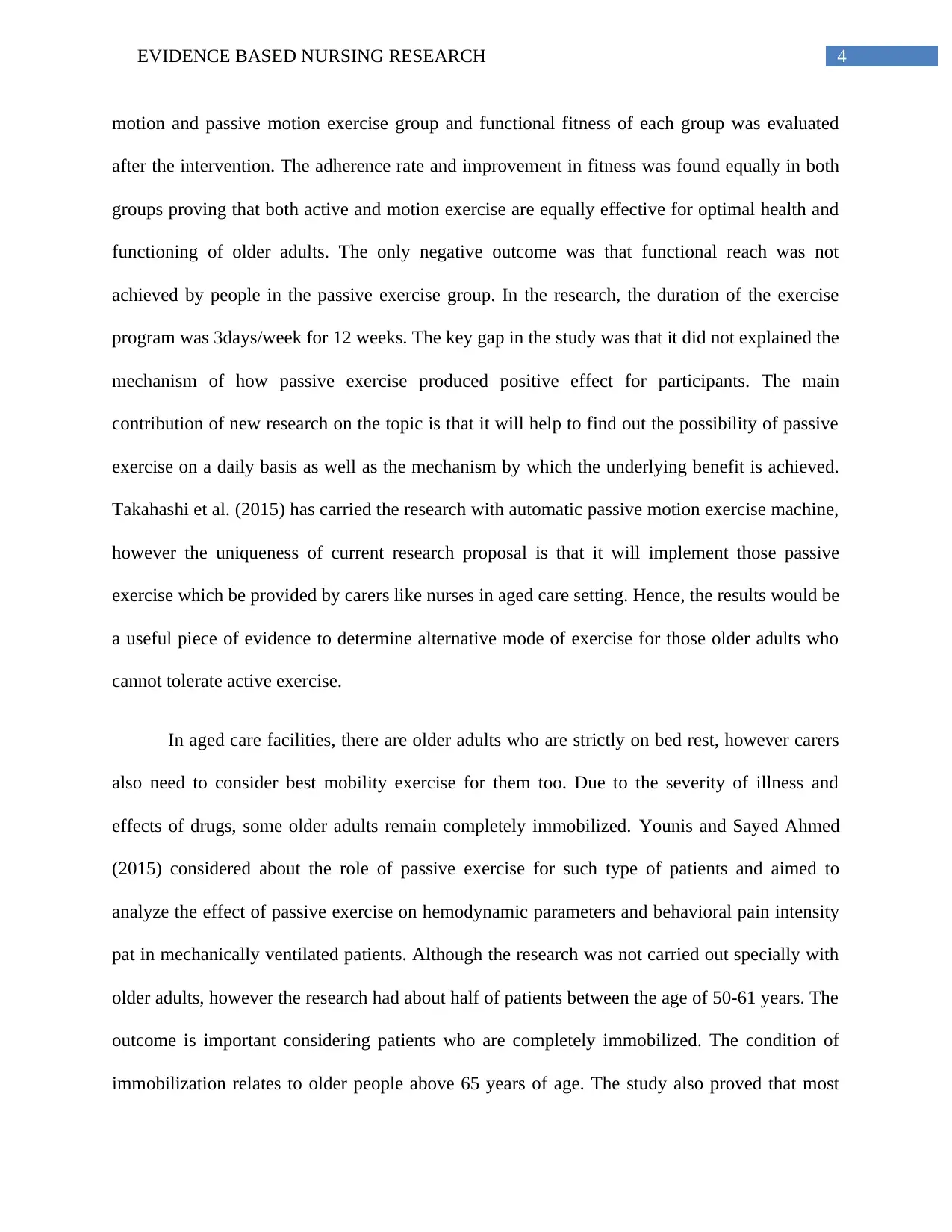
4EVIDENCE BASED NURSING RESEARCH
motion and passive motion exercise group and functional fitness of each group was evaluated
after the intervention. The adherence rate and improvement in fitness was found equally in both
groups proving that both active and motion exercise are equally effective for optimal health and
functioning of older adults. The only negative outcome was that functional reach was not
achieved by people in the passive exercise group. In the research, the duration of the exercise
program was 3days/week for 12 weeks. The key gap in the study was that it did not explained the
mechanism of how passive exercise produced positive effect for participants. The main
contribution of new research on the topic is that it will help to find out the possibility of passive
exercise on a daily basis as well as the mechanism by which the underlying benefit is achieved.
Takahashi et al. (2015) has carried the research with automatic passive motion exercise machine,
however the uniqueness of current research proposal is that it will implement those passive
exercise which be provided by carers like nurses in aged care setting. Hence, the results would be
a useful piece of evidence to determine alternative mode of exercise for those older adults who
cannot tolerate active exercise.
In aged care facilities, there are older adults who are strictly on bed rest, however carers
also need to consider best mobility exercise for them too. Due to the severity of illness and
effects of drugs, some older adults remain completely immobilized. Younis and Sayed Ahmed
(2015) considered about the role of passive exercise for such type of patients and aimed to
analyze the effect of passive exercise on hemodynamic parameters and behavioral pain intensity
pat in mechanically ventilated patients. Although the research was not carried out specially with
older adults, however the research had about half of patients between the age of 50-61 years. The
outcome is important considering patients who are completely immobilized. The condition of
immobilization relates to older people above 65 years of age. The study also proved that most
motion and passive motion exercise group and functional fitness of each group was evaluated
after the intervention. The adherence rate and improvement in fitness was found equally in both
groups proving that both active and motion exercise are equally effective for optimal health and
functioning of older adults. The only negative outcome was that functional reach was not
achieved by people in the passive exercise group. In the research, the duration of the exercise
program was 3days/week for 12 weeks. The key gap in the study was that it did not explained the
mechanism of how passive exercise produced positive effect for participants. The main
contribution of new research on the topic is that it will help to find out the possibility of passive
exercise on a daily basis as well as the mechanism by which the underlying benefit is achieved.
Takahashi et al. (2015) has carried the research with automatic passive motion exercise machine,
however the uniqueness of current research proposal is that it will implement those passive
exercise which be provided by carers like nurses in aged care setting. Hence, the results would be
a useful piece of evidence to determine alternative mode of exercise for those older adults who
cannot tolerate active exercise.
In aged care facilities, there are older adults who are strictly on bed rest, however carers
also need to consider best mobility exercise for them too. Due to the severity of illness and
effects of drugs, some older adults remain completely immobilized. Younis and Sayed Ahmed
(2015) considered about the role of passive exercise for such type of patients and aimed to
analyze the effect of passive exercise on hemodynamic parameters and behavioral pain intensity
pat in mechanically ventilated patients. Although the research was not carried out specially with
older adults, however the research had about half of patients between the age of 50-61 years. The
outcome is important considering patients who are completely immobilized. The condition of
immobilization relates to older people above 65 years of age. The study also proved that most
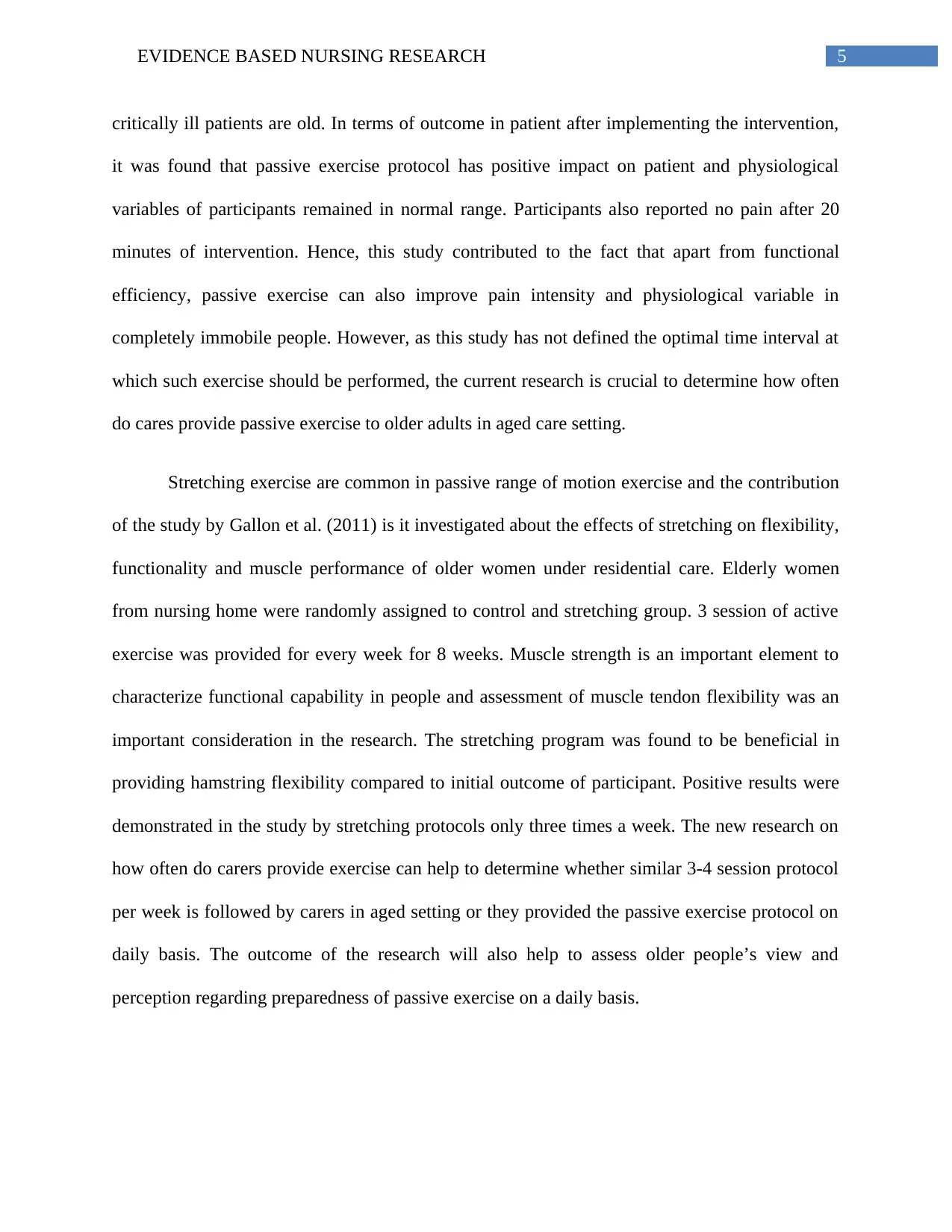
5EVIDENCE BASED NURSING RESEARCH
critically ill patients are old. In terms of outcome in patient after implementing the intervention,
it was found that passive exercise protocol has positive impact on patient and physiological
variables of participants remained in normal range. Participants also reported no pain after 20
minutes of intervention. Hence, this study contributed to the fact that apart from functional
efficiency, passive exercise can also improve pain intensity and physiological variable in
completely immobile people. However, as this study has not defined the optimal time interval at
which such exercise should be performed, the current research is crucial to determine how often
do cares provide passive exercise to older adults in aged care setting.
Stretching exercise are common in passive range of motion exercise and the contribution
of the study by Gallon et al. (2011) is it investigated about the effects of stretching on flexibility,
functionality and muscle performance of older women under residential care. Elderly women
from nursing home were randomly assigned to control and stretching group. 3 session of active
exercise was provided for every week for 8 weeks. Muscle strength is an important element to
characterize functional capability in people and assessment of muscle tendon flexibility was an
important consideration in the research. The stretching program was found to be beneficial in
providing hamstring flexibility compared to initial outcome of participant. Positive results were
demonstrated in the study by stretching protocols only three times a week. The new research on
how often do carers provide exercise can help to determine whether similar 3-4 session protocol
per week is followed by carers in aged setting or they provided the passive exercise protocol on
daily basis. The outcome of the research will also help to assess older people’s view and
perception regarding preparedness of passive exercise on a daily basis.
critically ill patients are old. In terms of outcome in patient after implementing the intervention,
it was found that passive exercise protocol has positive impact on patient and physiological
variables of participants remained in normal range. Participants also reported no pain after 20
minutes of intervention. Hence, this study contributed to the fact that apart from functional
efficiency, passive exercise can also improve pain intensity and physiological variable in
completely immobile people. However, as this study has not defined the optimal time interval at
which such exercise should be performed, the current research is crucial to determine how often
do cares provide passive exercise to older adults in aged care setting.
Stretching exercise are common in passive range of motion exercise and the contribution
of the study by Gallon et al. (2011) is it investigated about the effects of stretching on flexibility,
functionality and muscle performance of older women under residential care. Elderly women
from nursing home were randomly assigned to control and stretching group. 3 session of active
exercise was provided for every week for 8 weeks. Muscle strength is an important element to
characterize functional capability in people and assessment of muscle tendon flexibility was an
important consideration in the research. The stretching program was found to be beneficial in
providing hamstring flexibility compared to initial outcome of participant. Positive results were
demonstrated in the study by stretching protocols only three times a week. The new research on
how often do carers provide exercise can help to determine whether similar 3-4 session protocol
per week is followed by carers in aged setting or they provided the passive exercise protocol on
daily basis. The outcome of the research will also help to assess older people’s view and
perception regarding preparedness of passive exercise on a daily basis.
⊘ This is a preview!⊘
Do you want full access?
Subscribe today to unlock all pages.

Trusted by 1+ million students worldwide
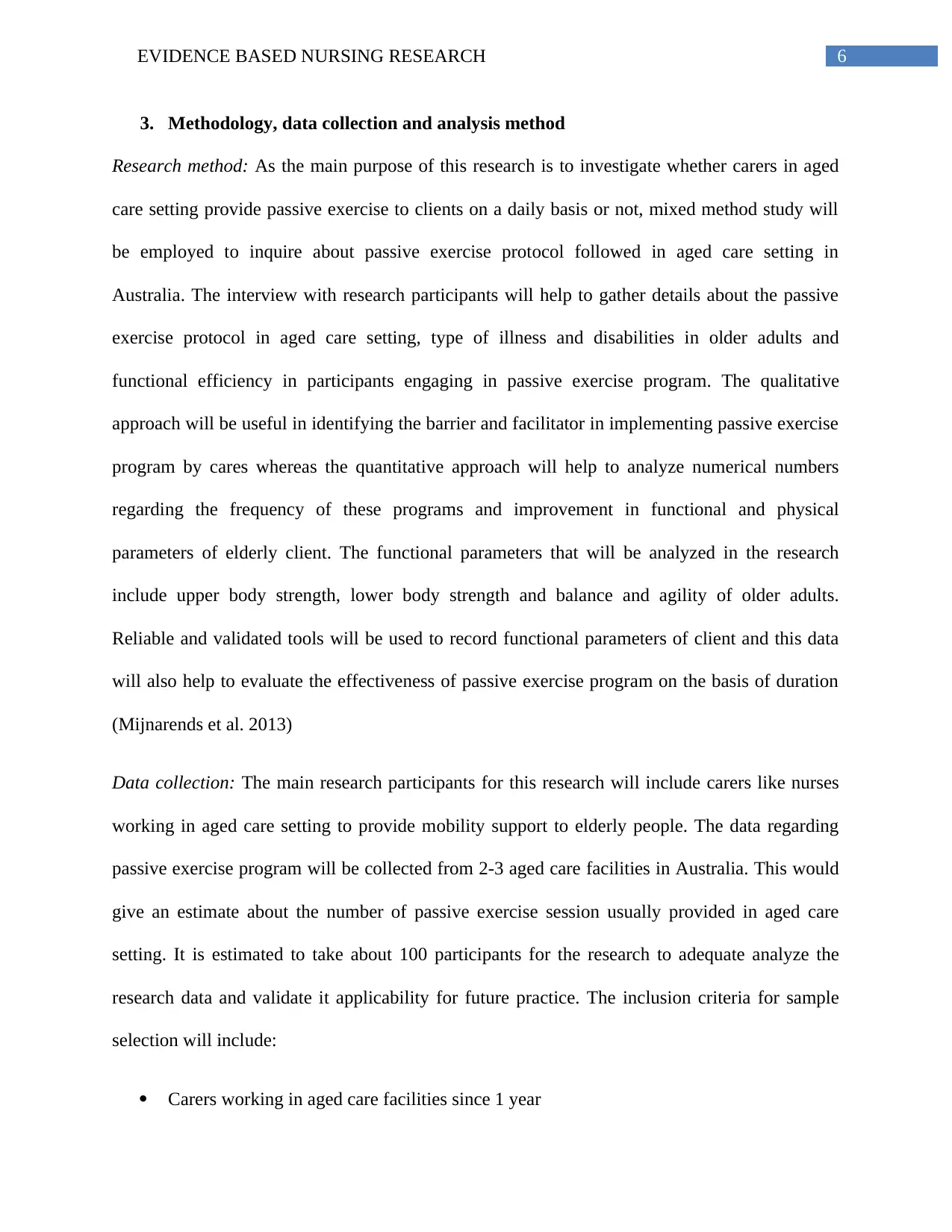
6EVIDENCE BASED NURSING RESEARCH
3. Methodology, data collection and analysis method
Research method: As the main purpose of this research is to investigate whether carers in aged
care setting provide passive exercise to clients on a daily basis or not, mixed method study will
be employed to inquire about passive exercise protocol followed in aged care setting in
Australia. The interview with research participants will help to gather details about the passive
exercise protocol in aged care setting, type of illness and disabilities in older adults and
functional efficiency in participants engaging in passive exercise program. The qualitative
approach will be useful in identifying the barrier and facilitator in implementing passive exercise
program by cares whereas the quantitative approach will help to analyze numerical numbers
regarding the frequency of these programs and improvement in functional and physical
parameters of elderly client. The functional parameters that will be analyzed in the research
include upper body strength, lower body strength and balance and agility of older adults.
Reliable and validated tools will be used to record functional parameters of client and this data
will also help to evaluate the effectiveness of passive exercise program on the basis of duration
(Mijnarends et al. 2013)
Data collection: The main research participants for this research will include carers like nurses
working in aged care setting to provide mobility support to elderly people. The data regarding
passive exercise program will be collected from 2-3 aged care facilities in Australia. This would
give an estimate about the number of passive exercise session usually provided in aged care
setting. It is estimated to take about 100 participants for the research to adequate analyze the
research data and validate it applicability for future practice. The inclusion criteria for sample
selection will include:
Carers working in aged care facilities since 1 year
3. Methodology, data collection and analysis method
Research method: As the main purpose of this research is to investigate whether carers in aged
care setting provide passive exercise to clients on a daily basis or not, mixed method study will
be employed to inquire about passive exercise protocol followed in aged care setting in
Australia. The interview with research participants will help to gather details about the passive
exercise protocol in aged care setting, type of illness and disabilities in older adults and
functional efficiency in participants engaging in passive exercise program. The qualitative
approach will be useful in identifying the barrier and facilitator in implementing passive exercise
program by cares whereas the quantitative approach will help to analyze numerical numbers
regarding the frequency of these programs and improvement in functional and physical
parameters of elderly client. The functional parameters that will be analyzed in the research
include upper body strength, lower body strength and balance and agility of older adults.
Reliable and validated tools will be used to record functional parameters of client and this data
will also help to evaluate the effectiveness of passive exercise program on the basis of duration
(Mijnarends et al. 2013)
Data collection: The main research participants for this research will include carers like nurses
working in aged care setting to provide mobility support to elderly people. The data regarding
passive exercise program will be collected from 2-3 aged care facilities in Australia. This would
give an estimate about the number of passive exercise session usually provided in aged care
setting. It is estimated to take about 100 participants for the research to adequate analyze the
research data and validate it applicability for future practice. The inclusion criteria for sample
selection will include:
Carers working in aged care facilities since 1 year
Paraphrase This Document
Need a fresh take? Get an instant paraphrase of this document with our AI Paraphraser
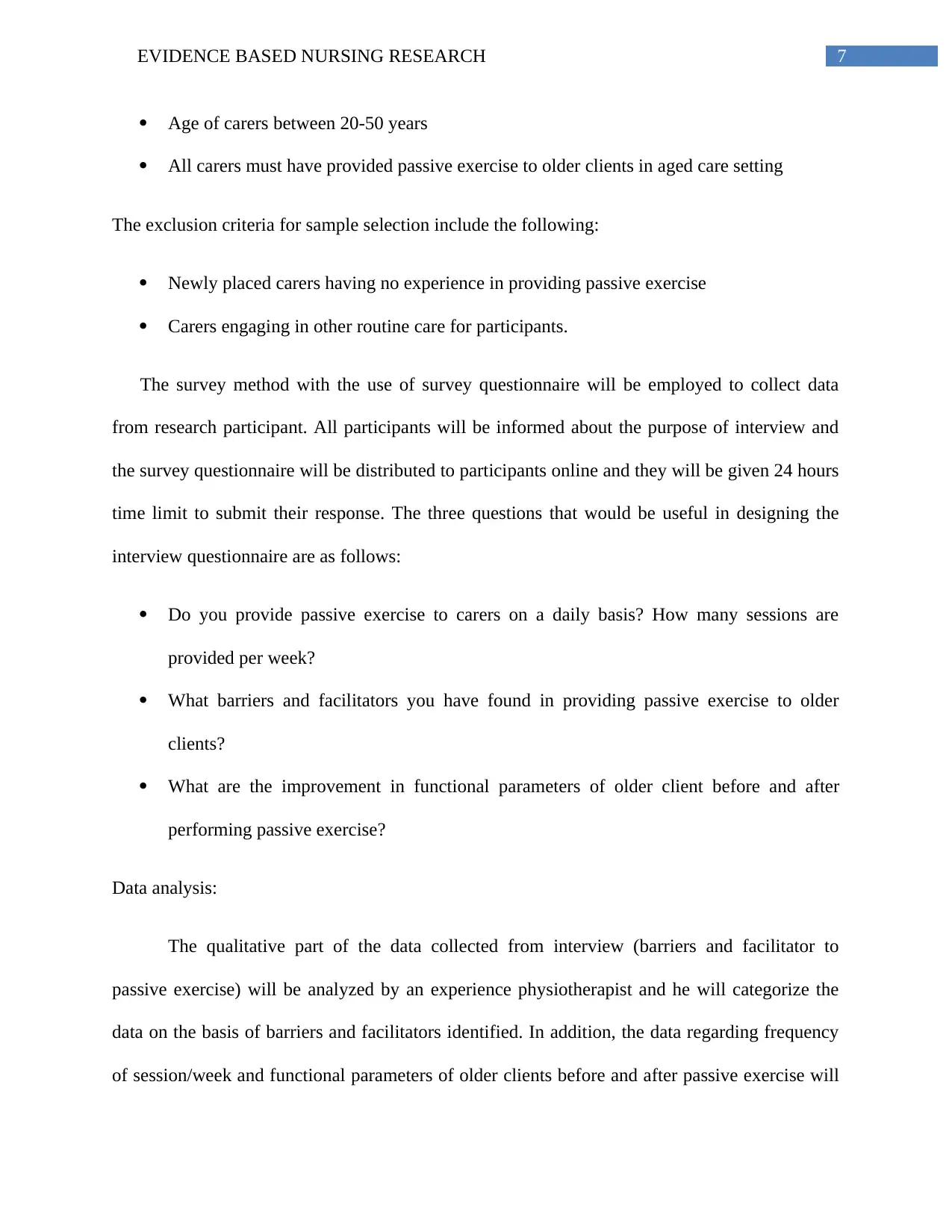
7EVIDENCE BASED NURSING RESEARCH
Age of carers between 20-50 years
All carers must have provided passive exercise to older clients in aged care setting
The exclusion criteria for sample selection include the following:
Newly placed carers having no experience in providing passive exercise
Carers engaging in other routine care for participants.
The survey method with the use of survey questionnaire will be employed to collect data
from research participant. All participants will be informed about the purpose of interview and
the survey questionnaire will be distributed to participants online and they will be given 24 hours
time limit to submit their response. The three questions that would be useful in designing the
interview questionnaire are as follows:
Do you provide passive exercise to carers on a daily basis? How many sessions are
provided per week?
What barriers and facilitators you have found in providing passive exercise to older
clients?
What are the improvement in functional parameters of older client before and after
performing passive exercise?
Data analysis:
The qualitative part of the data collected from interview (barriers and facilitator to
passive exercise) will be analyzed by an experience physiotherapist and he will categorize the
data on the basis of barriers and facilitators identified. In addition, the data regarding frequency
of session/week and functional parameters of older clients before and after passive exercise will
Age of carers between 20-50 years
All carers must have provided passive exercise to older clients in aged care setting
The exclusion criteria for sample selection include the following:
Newly placed carers having no experience in providing passive exercise
Carers engaging in other routine care for participants.
The survey method with the use of survey questionnaire will be employed to collect data
from research participant. All participants will be informed about the purpose of interview and
the survey questionnaire will be distributed to participants online and they will be given 24 hours
time limit to submit their response. The three questions that would be useful in designing the
interview questionnaire are as follows:
Do you provide passive exercise to carers on a daily basis? How many sessions are
provided per week?
What barriers and facilitators you have found in providing passive exercise to older
clients?
What are the improvement in functional parameters of older client before and after
performing passive exercise?
Data analysis:
The qualitative part of the data collected from interview (barriers and facilitator to
passive exercise) will be analyzed by an experience physiotherapist and he will categorize the
data on the basis of barriers and facilitators identified. In addition, the data regarding frequency
of session/week and functional parameters of older clients before and after passive exercise will
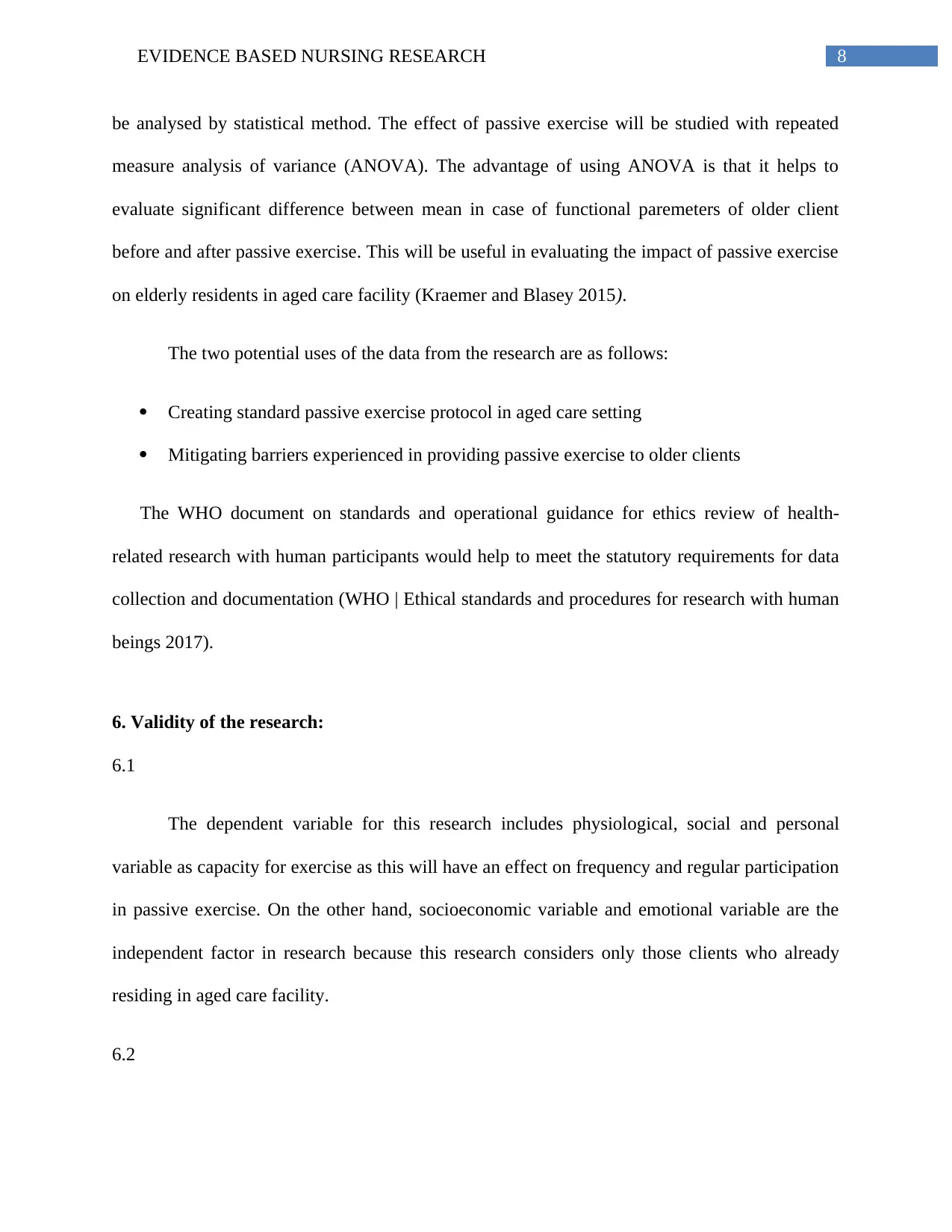
8EVIDENCE BASED NURSING RESEARCH
be analysed by statistical method. The effect of passive exercise will be studied with repeated
measure analysis of variance (ANOVA). The advantage of using ANOVA is that it helps to
evaluate significant difference between mean in case of functional paremeters of older client
before and after passive exercise. This will be useful in evaluating the impact of passive exercise
on elderly residents in aged care facility (Kraemer and Blasey 2015).
The two potential uses of the data from the research are as follows:
Creating standard passive exercise protocol in aged care setting
Mitigating barriers experienced in providing passive exercise to older clients
The WHO document on standards and operational guidance for ethics review of health-
related research with human participants would help to meet the statutory requirements for data
collection and documentation (WHO | Ethical standards and procedures for research with human
beings 2017).
6. Validity of the research:
6.1
The dependent variable for this research includes physiological, social and personal
variable as capacity for exercise as this will have an effect on frequency and regular participation
in passive exercise. On the other hand, socioeconomic variable and emotional variable are the
independent factor in research because this research considers only those clients who already
residing in aged care facility.
6.2
be analysed by statistical method. The effect of passive exercise will be studied with repeated
measure analysis of variance (ANOVA). The advantage of using ANOVA is that it helps to
evaluate significant difference between mean in case of functional paremeters of older client
before and after passive exercise. This will be useful in evaluating the impact of passive exercise
on elderly residents in aged care facility (Kraemer and Blasey 2015).
The two potential uses of the data from the research are as follows:
Creating standard passive exercise protocol in aged care setting
Mitigating barriers experienced in providing passive exercise to older clients
The WHO document on standards and operational guidance for ethics review of health-
related research with human participants would help to meet the statutory requirements for data
collection and documentation (WHO | Ethical standards and procedures for research with human
beings 2017).
6. Validity of the research:
6.1
The dependent variable for this research includes physiological, social and personal
variable as capacity for exercise as this will have an effect on frequency and regular participation
in passive exercise. On the other hand, socioeconomic variable and emotional variable are the
independent factor in research because this research considers only those clients who already
residing in aged care facility.
6.2
⊘ This is a preview!⊘
Do you want full access?
Subscribe today to unlock all pages.

Trusted by 1+ million students worldwide
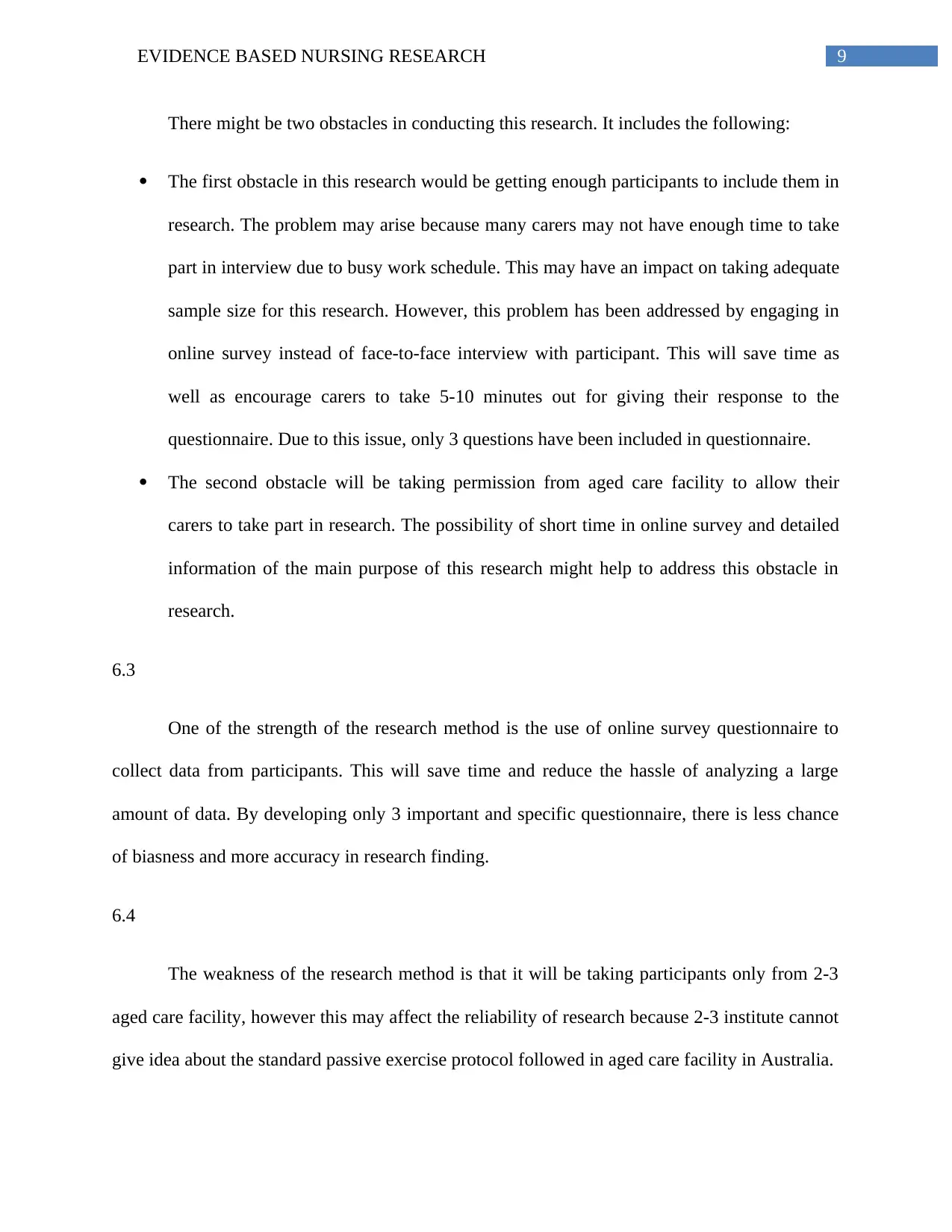
9EVIDENCE BASED NURSING RESEARCH
There might be two obstacles in conducting this research. It includes the following:
The first obstacle in this research would be getting enough participants to include them in
research. The problem may arise because many carers may not have enough time to take
part in interview due to busy work schedule. This may have an impact on taking adequate
sample size for this research. However, this problem has been addressed by engaging in
online survey instead of face-to-face interview with participant. This will save time as
well as encourage carers to take 5-10 minutes out for giving their response to the
questionnaire. Due to this issue, only 3 questions have been included in questionnaire.
The second obstacle will be taking permission from aged care facility to allow their
carers to take part in research. The possibility of short time in online survey and detailed
information of the main purpose of this research might help to address this obstacle in
research.
6.3
One of the strength of the research method is the use of online survey questionnaire to
collect data from participants. This will save time and reduce the hassle of analyzing a large
amount of data. By developing only 3 important and specific questionnaire, there is less chance
of biasness and more accuracy in research finding.
6.4
The weakness of the research method is that it will be taking participants only from 2-3
aged care facility, however this may affect the reliability of research because 2-3 institute cannot
give idea about the standard passive exercise protocol followed in aged care facility in Australia.
There might be two obstacles in conducting this research. It includes the following:
The first obstacle in this research would be getting enough participants to include them in
research. The problem may arise because many carers may not have enough time to take
part in interview due to busy work schedule. This may have an impact on taking adequate
sample size for this research. However, this problem has been addressed by engaging in
online survey instead of face-to-face interview with participant. This will save time as
well as encourage carers to take 5-10 minutes out for giving their response to the
questionnaire. Due to this issue, only 3 questions have been included in questionnaire.
The second obstacle will be taking permission from aged care facility to allow their
carers to take part in research. The possibility of short time in online survey and detailed
information of the main purpose of this research might help to address this obstacle in
research.
6.3
One of the strength of the research method is the use of online survey questionnaire to
collect data from participants. This will save time and reduce the hassle of analyzing a large
amount of data. By developing only 3 important and specific questionnaire, there is less chance
of biasness and more accuracy in research finding.
6.4
The weakness of the research method is that it will be taking participants only from 2-3
aged care facility, however this may affect the reliability of research because 2-3 institute cannot
give idea about the standard passive exercise protocol followed in aged care facility in Australia.
Paraphrase This Document
Need a fresh take? Get an instant paraphrase of this document with our AI Paraphraser
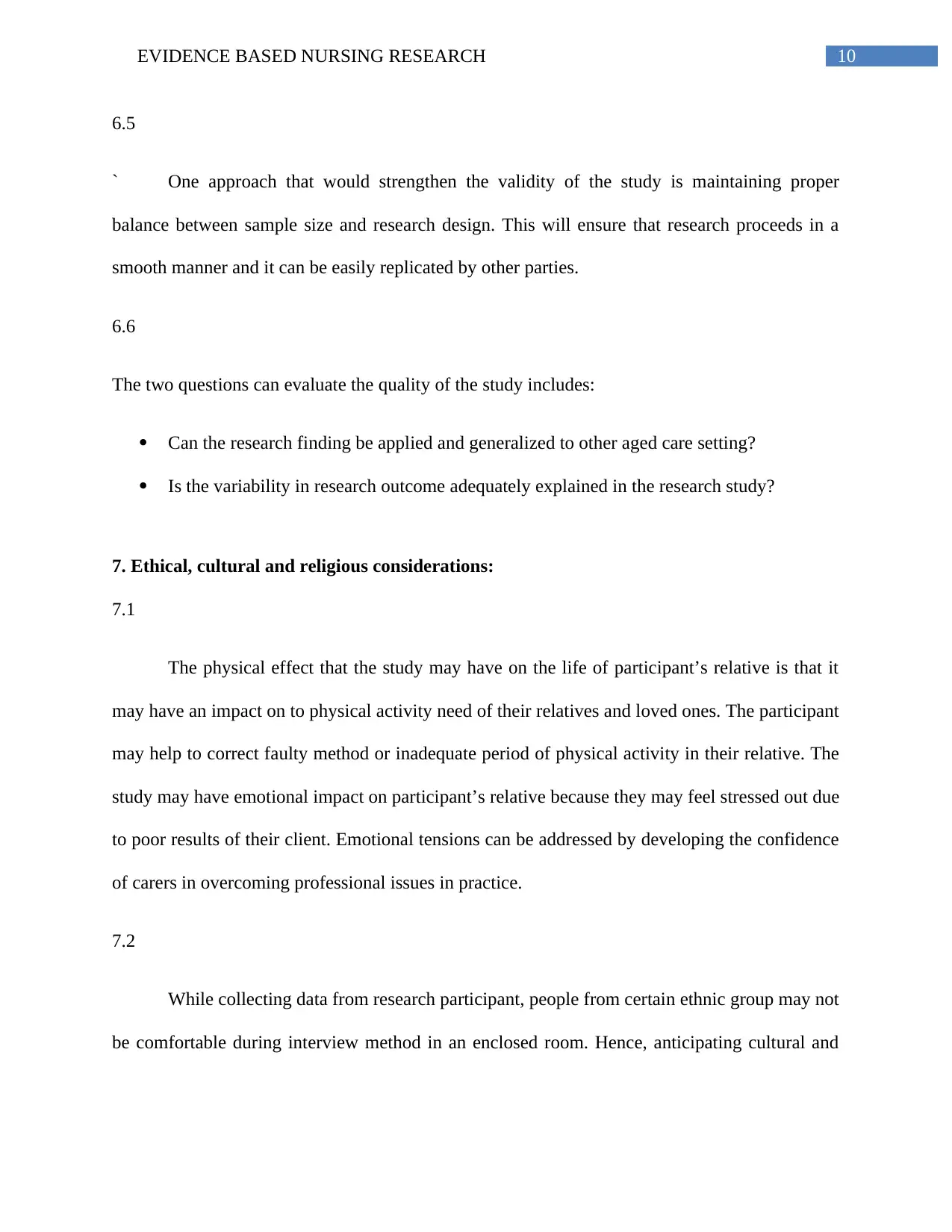
10EVIDENCE BASED NURSING RESEARCH
6.5
` One approach that would strengthen the validity of the study is maintaining proper
balance between sample size and research design. This will ensure that research proceeds in a
smooth manner and it can be easily replicated by other parties.
6.6
The two questions can evaluate the quality of the study includes:
Can the research finding be applied and generalized to other aged care setting?
Is the variability in research outcome adequately explained in the research study?
7. Ethical, cultural and religious considerations:
7.1
The physical effect that the study may have on the life of participant’s relative is that it
may have an impact on to physical activity need of their relatives and loved ones. The participant
may help to correct faulty method or inadequate period of physical activity in their relative. The
study may have emotional impact on participant’s relative because they may feel stressed out due
to poor results of their client. Emotional tensions can be addressed by developing the confidence
of carers in overcoming professional issues in practice.
7.2
While collecting data from research participant, people from certain ethnic group may not
be comfortable during interview method in an enclosed room. Hence, anticipating cultural and
6.5
` One approach that would strengthen the validity of the study is maintaining proper
balance between sample size and research design. This will ensure that research proceeds in a
smooth manner and it can be easily replicated by other parties.
6.6
The two questions can evaluate the quality of the study includes:
Can the research finding be applied and generalized to other aged care setting?
Is the variability in research outcome adequately explained in the research study?
7. Ethical, cultural and religious considerations:
7.1
The physical effect that the study may have on the life of participant’s relative is that it
may have an impact on to physical activity need of their relatives and loved ones. The participant
may help to correct faulty method or inadequate period of physical activity in their relative. The
study may have emotional impact on participant’s relative because they may feel stressed out due
to poor results of their client. Emotional tensions can be addressed by developing the confidence
of carers in overcoming professional issues in practice.
7.2
While collecting data from research participant, people from certain ethnic group may not
be comfortable during interview method in an enclosed room. Hence, anticipating cultural and
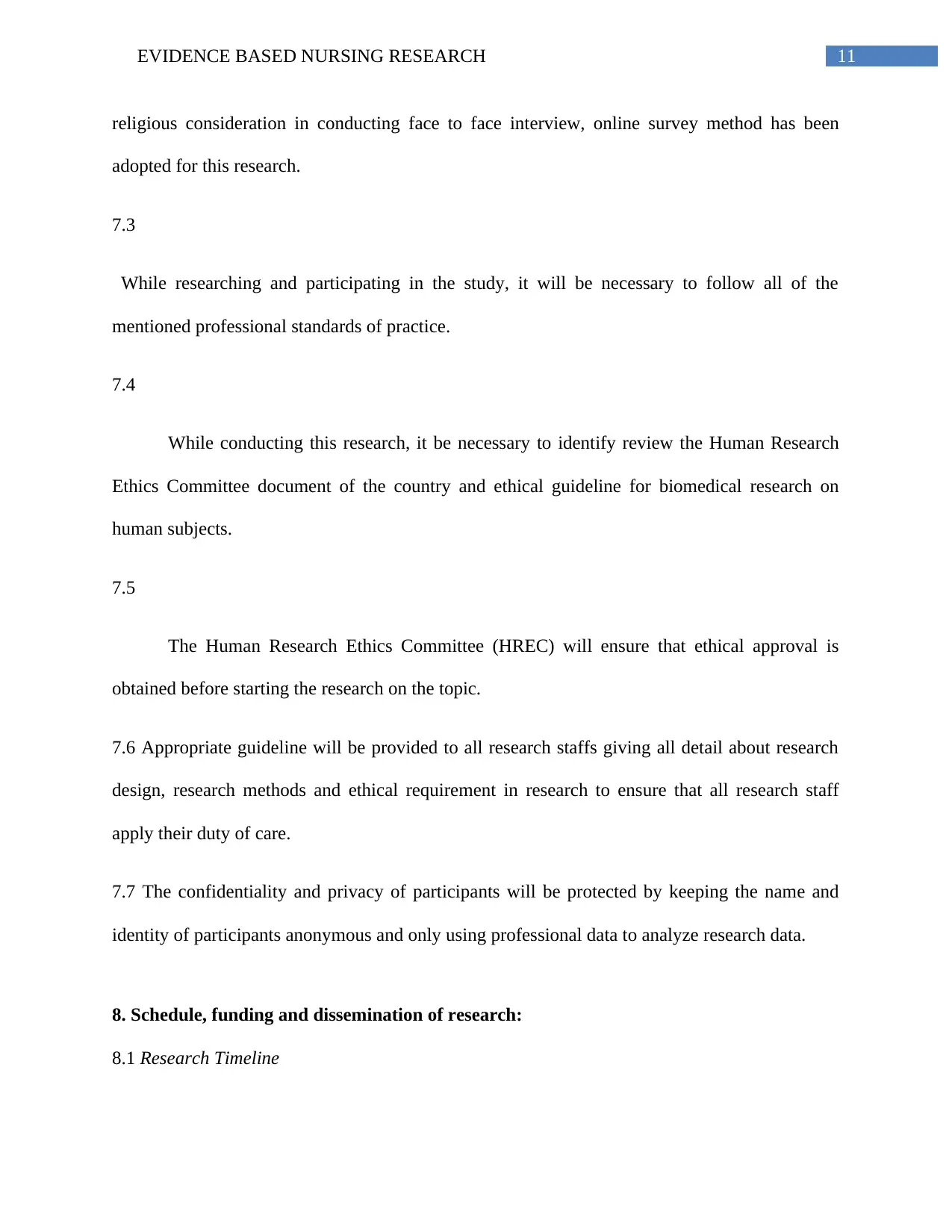
11EVIDENCE BASED NURSING RESEARCH
religious consideration in conducting face to face interview, online survey method has been
adopted for this research.
7.3
While researching and participating in the study, it will be necessary to follow all of the
mentioned professional standards of practice.
7.4
While conducting this research, it be necessary to identify review the Human Research
Ethics Committee document of the country and ethical guideline for biomedical research on
human subjects.
7.5
The Human Research Ethics Committee (HREC) will ensure that ethical approval is
obtained before starting the research on the topic.
7.6 Appropriate guideline will be provided to all research staffs giving all detail about research
design, research methods and ethical requirement in research to ensure that all research staff
apply their duty of care.
7.7 The confidentiality and privacy of participants will be protected by keeping the name and
identity of participants anonymous and only using professional data to analyze research data.
8. Schedule, funding and dissemination of research:
8.1 Research Timeline
religious consideration in conducting face to face interview, online survey method has been
adopted for this research.
7.3
While researching and participating in the study, it will be necessary to follow all of the
mentioned professional standards of practice.
7.4
While conducting this research, it be necessary to identify review the Human Research
Ethics Committee document of the country and ethical guideline for biomedical research on
human subjects.
7.5
The Human Research Ethics Committee (HREC) will ensure that ethical approval is
obtained before starting the research on the topic.
7.6 Appropriate guideline will be provided to all research staffs giving all detail about research
design, research methods and ethical requirement in research to ensure that all research staff
apply their duty of care.
7.7 The confidentiality and privacy of participants will be protected by keeping the name and
identity of participants anonymous and only using professional data to analyze research data.
8. Schedule, funding and dissemination of research:
8.1 Research Timeline
⊘ This is a preview!⊘
Do you want full access?
Subscribe today to unlock all pages.

Trusted by 1+ million students worldwide
1 out of 18
Related Documents
Your All-in-One AI-Powered Toolkit for Academic Success.
+13062052269
info@desklib.com
Available 24*7 on WhatsApp / Email
![[object Object]](/_next/static/media/star-bottom.7253800d.svg)
Unlock your academic potential
Copyright © 2020–2025 A2Z Services. All Rights Reserved. Developed and managed by ZUCOL.





